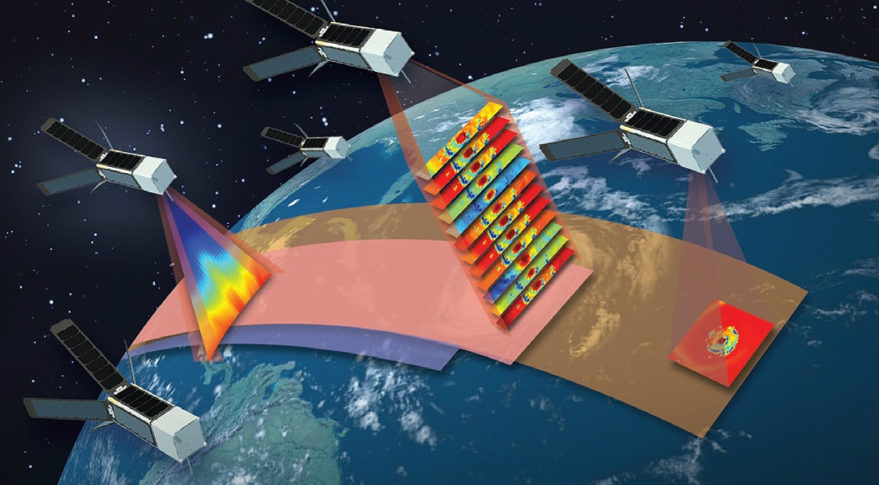NOAA Sees Smallsats as Good Gap Fillers for Weather System

SAN FRANCISCO — The U.S. National Oceanic and Atmospheric Administration is interested in using miniature satellites to gather data it can feed into the agency's weather prediction models to augment data provided by its fleet of large spacecraft.
"The idea is that for much less money and much less time, we will be able to get data that are good enough to help mitigate gaps," said Margaret Caulfield, division chief in NOAA National Environmental Satellite, Data and Information Service's office of projects, planning and analysis.
NOAA officials are particularly concerned that the agency will experience a gap in polar satellite data if the Suomi National Polar-orbiting Partnershi (NPP) spacecraft fails before its successor, the first Joint Polar Satellite System (JPSS-1) spacecraft begins providing data. NOAA polar-orbiting satellites, NOAA-15 and NOAA-18, have drifted out of their afternoon orbits. Meanwhile, the NPP satellite, launched in October 2011, has exceeded its five-year design life and JPSS-1 is scheduled to launch in March on a United Launch Alliance Delta 2 from Vandenberg Air Force Base in California. [Small Satellites Spur Space Innovations | Video]
"To mitigate that gap, we need to get new observations and we propose to do that with small satellites," Caulfield said. "Small satellites are particularly suited to this because they are an affordable source of mitigation data with short, responsive call-up times."
Specifically, NOAA in interested in using small satellites equipped with microwave and infrared sounders as well as visible infrared cameras. If those programs are successful, the agency "would like to go further and use small satellites to augment operational capabilities," Caulfield said Dec. 14 during a presentation at the American Geophysical Union conference here.
To gather microwave data, NOAA is interested in radiometers the Massachusetts Institute of Technology's Lincoln Laboratory developed for NASA's Microsized Microwave Atmospheric Satellite and the Microwave Radiometer Technology Acceleration.
"All the components have heritage and high maturity," Caulfield said. "From our point of view we are ready to proceed" with a NOAA microwave sounder.
Get the Space.com Newsletter
Breaking space news, the latest updates on rocket launches, skywatching events and more!
NOAA also is drawing on infrared sounding technology NASA plans to demonstrate in 2018 with its Cubesat Infrared Atmospheric Sounder developed by Jet Propulsion Laboratory engineers. NOAA would need to modify that instrument to turn it into an operational weather sensor, Caulfield said.
To make sure the measurements provided by the cubesat sensors would be useful, NOAA is simulating the type of data it would obtain from the new instruments and determining how well that data supports weather forecast models.
NOAA is turning to the U.S. Department of Defense to find technology the agency could draw on to obtain infrared imagery with cubesats. That technology is not as mature as the infrared and microwave sounders, Caulfield said.
In addition to flying its own small satellites, NOAA is looking into the possibility of obtaining data from two NASA constellations focused on tropical storms, the 12-cubesat Time-Resolved Observations of Precipitation structure and storm Intensity with a Constellation of Smallsats (TROPICS) mission and the eight-satellite Cyclone Global Navigation Satellite System that launched Dec. 15. Once the NASA missions complete their science objectives, NOAA could use the data they obtain in its weather prediction models. "For as long as those satellites live, we would like them to become a part of weather prediction," Caulfield said.
This story was provided by SpaceNews, dedicated to covering all aspects of the space industry.
Join our Space Forums to keep talking space on the latest missions, night sky and more! And if you have a news tip, correction or comment, let us know at: community@space.com.
Debra Werner is a correspondent for SpaceNews based in San Francisco. She earned a bachelor’s degree in communications from the University of California, Berkeley, and a master’s degree in journalism from Northwestern University. Debra is a recipient of the 1989 Gerald Ford Prize for Distinguished Reporting on National Defense. Her SN Commercial Drive newsletter is sent out on Wednesdays.










